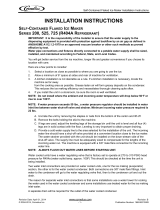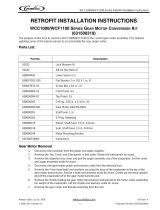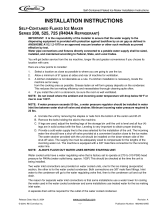
NME1254 & FME1504
January 2000
Page 1
INTRODUCTION
To the owner or user: The service manual you are
reading is intended to provide you, and the
maintenance or service technician, with the
information needed to install, start up, clean,
maintain, and service either ice system.
Both models feature: front service for the
evaporator, gearmotor, control box, water reservoir
and bin control; electronic circuitry for monitoring
ice and water level; a thermostatic expansion
valve; and R-404A as the refrigerant.
Table of Contents
FOR THE INSTALLER ,,,,,,,,,,,,,,,,,,,,,,,,,,,,,,,,,,,, Page 2
FOR THE INSTALLER: Environmental Limitations ,,,,,,,,,,,,,,,,,,,,, Page 3
FOR THE INSTALLER ,,,,,,,,,,,,,,,,,,,,,,,,,,,,,,,,,,,, Page 4
FOR THE PLUMBER ,,,,,,,,,,,,,,,,,,,,,,,,,,,,,,,,,,,,, Page 5
FOR THE ELECTRICIAN ,,,,,,,,,,,,,,,,,,,,,,,,,,,,,,,,,, Page 6
FOR THE INSTALLER: Final Check List ,,,,,,,,,,,,,,,,,,,,,,,,,,, Page 7
START UP ,,,,,,,,,,,,,,,,,,,,,,,,,,,,,,,,,,,,,,,,,, Page 8
COMPONENT DESCRIPTION ,,,,,,,,,,,,,,,,,,,,,,,,,,,,,,,, Page 9
Control Box ,,,,,,,,,,,,,,,,,,,,,,,,,,,,,,,,,,,,,,,,,, Page 10
ELECTRICAL SEQUENCE: ,,,,,,,,,,,,,,,,,,,,,,,,,,,,,,,,, Page 11
COMPONENT DESCRIPTION ,,,,,,,,,,,,,,,,,,,,,,,,,,,,,,,, Page 12
OPERATION ,,,,,,,,,,,,,,,,,,,,,,,,,,,,,,,,,,,,,,,,, Page 13
OPERATION: Refrigeration ,,,,,,,,,,,,,,,,,,,,,,,,,,,,,,,,, Page 14
CLEANING & SANITIZING ,,,,,,,,,,,,,,,,,,,,,,,,,,,,,,,,,, Page 15
SENSOR and CONDENSER MAINTENANCE ,,,,,,,,,,,,,,,,,,,,,,,, Page 16
BEARING MAINTENANCE ,,,,,,,,,,,,,,,,,,,,,,,,,,,,,,,,,, Page 17
AUGER MAINTENANCE ,,,,,,,,,,,,,,,,,,,,,,,,,,,,,,,,,,, Page 18
SERVICE DIAGNOSIS: ,,,,,,,,,,,,,,,,,,,,,,,,,,,,,,,,,,, Page 19
SERVICE DIAGNOSIS ,,,,,,,,,,,,,,,,,,,,,,,,,,,,,,,,,,,, Page 20
CONTROL SYSTEM DIAGNOSTICS ,,,,,,,,,,,,,,,,,,,,,,,,,,,, Page 21
REMOVAL AND REPLACEMENT: Water Reservoir & Bin Control ,,,,,,,,,,,,, Page 22
REMOVAL AND REPLACEMENT: Bearing And Breaker ,,,,,,,,,,,,,,,,,, Page 23
REMOVAL AND REPLACEMENT: Auger ,,,,,,,,,,,,,,,,,,,,,,,,,, Page 24
REMOVAL AND REPLACEMENT: Water Seal ,,,,,,,,,,,,,,,,,,,,,,, Page 25
REMOVAL AND REPLACEMENT: Evaporator ,,,,,,,,,,,,,,,,,,,,,,, Page 26
REMOVAL AND REPLACEMENT: Gearmotor ,,,,,,,,,,,,,,,,,,,,,,,, Page 27
Refrigeration System Service ,,,,,,,,,,,,,,,,,,,,,,,,,,,,,,,, Page 28
What to Do Before Calling for Service ,,,,,,,,,,,,,,,,,,,,,,,,,,,, Page 29
This manual was printed on recycled paper.
Keep it for future reference.
Note this symbol when it appears.
It marks a potential hazard.























